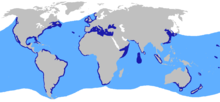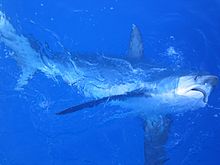Common thresher
| Common thresher | |
|---|---|

| |

| |
| Scientific classification | |
| Domain: | Eukaryota |
| Kingdom: | Animalia |
| Phylum: | Chordata |
| Class: | Chondrichthyes |
| Subclass: | Elasmobranchii |
| Subdivision: | Selachimorpha |
| Order: | Lamniformes |
| Family: | Alopiidae |
| Genus: | Alopias |
| Species: | A. vulpinus
|
| Binomial name | |
| Alopias vulpinus (Bonnaterre, 1788)
| |

| |
| Confirmed (dark blue) and suspected (light blue) range of the common thresher[3] | |
| Synonyms | |
| |
The common thresher (Alopias vulpinus), also known as Atlantic thresher, is the largest
The long tail of the common thresher, the source of many fanciful tales through history, is used in a whip-like fashion to deliver incapacitating blows to its prey.[
Despite its size, the common thresher is minimally dangerous to humans due to its relatively small teeth and timid disposition. It is highly valued by
Taxonomy and phylogeny

The first
The specific epithet vulpinus is derived from the Latin vulpes meaning "fox", and in some older literature the species name was given incorrectly as Alopias vulpes.[6] "Fox shark" is the earliest known English name for this species and is rooted in classical antiquity, from a belief that it was especially cunning. In the mid-19th century, the name "fox" was mostly superseded by "thresher", referencing the shark's flail-like use of its tail. This species is often known simply as thresher shark or thresher; Henry Bigelow and William Schroeder introduced the name "common thresher" in 1945 to differentiate it from the bigeye thresher (A. superciliosus).[7] It is also known by many other common names, including Atlantic thresher, grayfish, green thresher, long-tailed shark, sea ape, sea fox, slasher, swiveltail, thintail thresher, thrasher shark, and whiptail shark.[3][8]
Description


The common thresher is a fairly robust shark with a torpedo-shaped trunk and a short, broad head. The dorsal profile of the head curves evenly down to the pointed, conical snout. The eyes are moderately large and lack
The long, falcate (sickle-shaped) pectoral fins taper to narrowly pointed tips. The first
The skin is covered by small, overlapping
Distribution
The range of the common thresher encompasses
The common thresher is
Habitat
Common threshers are inhabitants of both
Biology and ecology
Common threshers are active, strong swimmers, with infrequent reports of them leaping completely out of the water.
Immature common threshers fall
Feeding

The long upper tailfin lobe of the common thresher is used to strike and incapacitate prey.[10]
Some 97% of the common thresher's diet is composed of
Numerous accounts have been given of common threshers using the long upper lobes of their tail fins to stun prey, and they are often snagged on
Life history

Like other mackerel sharks, common threshers are
Newborn pups usually measure 114–160 cm (3.74–5.25 ft) long and weigh 5–6 kg (11–13 lb), depending on the size of the mother. The juveniles grow about 50 cm (1.6 ft) a year, while adults grow about 10 cm (0.33 ft) a year.[18] The size at maturation appears to vary between populations. In the eastern North Pacific, males mature at 3.3 m (11 ft) and five years old, and females around 2.6–4.5 m (8.5–14.8 ft) and seven years old. They are known to live to at least 15 years and their maximum lifespan has been estimated to be 45–50 years.[6][15]
Relationship with humans
While any large shark is capable of inflicting injury and thus merits respect, the common thresher poses little danger to humans. Most divers report that they are shy and difficult to approach under water. The International Shark Attack File lists a single provoked attack by the thresher shark and four attacks on boats, which were probably incidental from individuals fighting capture.[citation needed]
Commercial fishing

The common thresher is widely caught by offshore
In the United States, a drift gillnet fishery for the common thresher developed in southern California in 1977, beginning with 10 vessels experimenting with a larger-sized mesh. Within two years, the fleet had increased to 40 vessels, and the fishery peaked in 1982 when 228 vessels landed 1,091 metric tons. The common thresher population rapidly collapsed from overfishing, with landings decreasing to less than 300 metric tons a year by the late 1980s and larger size classes disappearing from the population.[15][42] Common threshers are still taken commercially in the United States, with about 85% coming from the Pacific and 15% from the Atlantic. The largest catches remain from the California-Oregon gillnet fishery, which had shifted its focus to the more valuable swordfish (Xiphias gladius), but still takes threshers as bycatch. Small numbers of Pacific threshers are also taken by harpoons, small-mesh driftnets, and longlines. In the Atlantic, threshers are primarily taken on longlines meant for swordfish and tuna.[43][44]
Recreational fishing
Common threshers are well regarded by
Conservation

All three thresher shark species were reassessed from
The United States manages common thresher fisheries by regulations such as commercial quotas and trip limits, and recreational minimum sizes and retention limits. Shark finning is illegal under U.S. federal law. The Atlantic common thresher fishery is regulated by the National Marine Fisheries Service Highly Migratory Species Management Division through the 2006 Consolidated Atlantic Highly Migratory Species Fishery Management Plan (FMP), and the Pacific common thresher fishery is regulated by the Pacific Fishery Management Council through the FMP for U.S. West Coast Fisheries for Highly Migratory Species.[43][44] In the 1990s, after the depletion of common thresher stocks by the California gillnet fishery, the fleet was limited to 70 boats and restrictions were placed on season, operation range, and landings. Some evidence shows the California subpopulation is recovering, and the potential population growth rate has been estimated to be 4–7% per year.[42]
In New Zealand, the Department of Conservation has classified the common thresher shark as "Not Threatened" under the New Zealand Threat Classification System.[47]
Historical perceptions
The
An oft-repeated myth about the common thresher is that they cooperate with
References
- ^ . Retrieved November 19, 2021.
- ^ "Appendices | CITES". cites.org. Retrieved January 14, 2022.
- ^ ISBN 92-5-104543-7.
- ^ Synonyms of Alopias vulpinus (Bonnaterre, 1788). Fishbase.org. Retrieved 2016-11-09.
- .
- ^ ISBN 0-520-23484-7.
- ^ ISBN 978-0-19-539294-4.
- ^ Froese, Rainer; Pauly, Daniel (eds.) (2012). "Alopias vulpinus" in FishBase. April 2012 version.
- JSTOR 1446753.
- ^ a b c d e f g h Martin, R.A. "Biology of the Common Thresher (Alopias vulpinus)". Biology of Sharks and Rays. ReefQuest Centre for Shark Research. Retrieved December 23, 2008.
- ^ Douglas, H. (2007). "Biggest thresher shark ever: caught off Cornish coast (again)". Newsletter of the Porcupine Marine Natural History Society. 23: 24–25.
- ISBN 978-0-520-94254-7.
- OCLC 38468784. Retrieved July 13, 2021.
- OCLC 908128805.
- ^ a b c d e f Species Fact Sheets: Alopias vulpinus (Bonnaterre, 1788. FAO Fisheries and Agriculture Department. Retrieved December 23, 2008.
- ^ Trejo, T. (2005). Global phylogeography of thresher sharks (Alopias spp.) inferred from mitochondrial DNA control region sequences (MSc thesis). Moss Landing Marine Laboratories, California State University. Archived from the original on February 2, 2019 – via Digital Commons of Moss Landing Marine Laboratories.
- ^ a b c Cartamil, Daniel P. (January 9, 2009), Movement patterns, habitat preferences, and fisheries biology of the common thresher shark (Alopias vulpinus) in the Southern California Bight, University of California, San Diego
- ^ a b c d Jordan, V. Biological Profiles: Thresher Shark. Florida Museum of Natural History. Retrieved December 23, 2008.
- .
- ^ Leonard, M. "A Firsthand Account of a Jumping Thresher Shark". Ichthyology. University of Florida Museum of Natural History. Archived from the original on December 27, 2008. Retrieved December 23, 2008.
- ^ Martin, R.A. "Common Thresher Shark". Biology of Sharks and Rays. ReefQuest Centre for Shark Research. Retrieved December 23, 2008.
- S2CID 84093424.
- ^ Weng, K.C.; Block, B.A. (2004). "Diel vertical migration of the bigeye thresher shark (Alopias superciliosus), a species possessing orbital retia mirabilia". Fishery Bulletin. 102 (1): 221–229.
- .
- PMID 18828561.
- S2CID 39872421.
- ^ Shvetsova, L.S. (1994). "Trematodes of cartilaginous fishes of the Pacific Ocean". Izvestiya TINRO. 117: 46–64.
- ^ Parukhin, A.M. (1966). "On the species composition of the helminth fauna of fishes in the South Atlantic". Materialy Nauchnoi Konferentsii Vsesoyuznogo Obshchestva Gel'mintologov. 3: 219–222.
- ^ Yamaguti, S. (1934). "Studies on the Helminth fauna of Japan. Part 4. Cestodes of fishes". Japanese Journal of Zoology. 6: 1–112.
- ^ Euzet, L. (1959). "Recherches sur les cestodes tetraphyllides des selaciens des cotes de France." Theses de PhD Faculte des Sciences, Université de Montpellier.
- ^ Bates, R.M. (1990). "A checklist of the Trypanorhyncha (Platyhelminthes: Cestoda) of the world (1935-1985)". National Museum of Wales, Zoological Series. 1: 1–218.
- S2CID 22538557.
- PMID 8885890.
- ^ Gomez Cabrera, S. (1983). "Forma adulta de Sphyriocephalus tergetinus (Cestoda: Tetrarhynchidea) en Alopias vulpinus (Peces: Selacea)". Revista Iberica de Parasitologia. 43 (3): 305.
- ^ .
- JSTOR 20787184.
- doi:10.1139/z87-327.
- .
- S2CID 22185843.
- ^ Preti, A.; Smith, S.E.; Ramon, D.A. (2004). "Diet differences in the thresher shark (Alopias vulpinus) during transition from a warm-water regime to a cool-water regime off California-Oregon, 1998–2000" (PDF). California Cooperative Oceanic Fisheries Investigations Report. 45: 118–125. Archived from the original (PDF) on August 8, 2017. Retrieved November 9, 2016.
- S2CID 27653232.
- ^ a b Mazurek, R. (2001). Seafood Watch Fishery Report: Sharks Volume I Common Thresher. MBA SeafoodWatch.
- ^ a b Atlantic Common Thresher Shark. FishWatch - U.S. Seafood Facts. Retrieved December 23, 2008.
- ^ a b Pacific Common Thresher Shark. FishWatch - U.S. Seafood Facts. Retrieved December 23, 2008.
- ISBN 0-8117-2673-8.
- ISBN 0-9787278-0-0.
- OCLC 1042901090.
- ISBN 978-1-4437-3729-6.
External links
- Alopias vulpinus, Thresher at FishBase
- Biological Profiles: Thresher Shark at Florida Museum of Natural History Ichthyology Department
- Biology of the Common Thresher (Alopias vulpinus) at ReefQuest Centre for Shark Research
- Species Fact Sheets: Alopias vulpinus at FAO Fisheries and Agriculture Department

